On IRA, Kant, Bohm and the I Ching
With IRA, we introduce an expansion of Kant’s transcendental metaphysics to include not just time, space and causality (the categories more specifically) but also as a landscape of what we might call, using Aristotelian terminology (and Manousakis 2006 refers to this in some way as well) as ‘potential’ reality. This reality is bound by our imagination, which has both an intellectual component (res virtualis), a metaphysical ground you could say, and a mental component (res cogitans) which is more of a rational and processing faculty of the (individual) mind – how things come together and relate to each other using transcendental aspects of the Intellect (res logica) which again include time, space and causality.
We follow mostly Kantian designations of the mind and cognition here, generally in terms of cognition, which represents this rational faculty of the mind, the transcendental aspect of it, which again includes time, space and causality and then the sensation, or intuitive aspect of the mind which is how we basically interface with physical reality. We are just creating another layer of metaphysical reality in this Intellectual space where the imagination reigns (the intellect or res virtualis). We embed this in an extended Cartesian terminology to arrive at our metaphysical architecture.
In this framework we find the at least somewhat familiar Cartesian ideas of res extensa and res cogitans, representing the classical distinction of reality between the world as we experience it, outside of ourselves – res extensa, things extended from us – and the world inside of us, res cogitans, things of thought or thinking (Hatfield 2018). We add to these, a pseudo-Kantian break of this mental world into appearances or (direct through the senses) representations of experiential reality, corresponding to Kant’s sensibility (that which is perceived through the senses by the mind), and conceptual objects in and of themselves that do not necessarily have a direct correspondence with experiential reality, a sort of abstractual conceptual overlay of experiential reality that helps us understand it, make sense of it, Kant’s understanding which he sees as sort of an analytic processing core which takes as inputs objects from then senses and then applies abstractions and relations to it to make sense of the world (Valdez 2022a).
If we look at the process of our experience of reality and our understanding of it holistically, and look at that process as starting with the physical ground, Kant’s world in and of itself (that he claims we cannot truly know), as it is experienced through the senses (Kant’s sensibility), understood through the mind (Kant’s understanding), framed by foundational concepts that hold it all together – time, space, causality which represent to Kant a priori constructs of the pure intuition and pure understanding which facilitate our understanding of the world. This is Kant’s transcendental idealism in a nutshell (Stang 2021, Valdez 2022). We’ve taken this framework, applied Cartesian language, and we’ve further broken it down into tiers, layers of abstraction, that facilitate the understanding of this metaphysical landscape and will provide the structure within which we will propose a mathematical formulation of how it is that ideas (explored at length below) can be understood to exist in this metaphysical framework – mathematically and algebraically speaking. Loosely our res cogitans corresponds to Kant’s notion of the sensibility, our res virtualis corresponds to his notion of the understanding, and our res logica corresponds to that level of abstraction that Kant calls a priori, the domain of metaphysics as he conceives of it. Res extensa in our system corresponds to the domain of physics, that which Kant doesn’t deal with at all but is essential to our system with respect to understanding how it is that (potential) ideas become actualized.
Along with Kantian metaphysics, we also apply some of the principles that were put forth by David Bohm in the latter part of the 21st century, Bohm being a pre-eminent physicist who is not only known for developing a fully deterministic formulation of Quantum Mechanics, Bohmian Mechanics, or de Broglie-Bohm theory (Bohm & Hiley 1993; Valdez 2019), but also put forth the notion of explicate and implicate order and holomovement to describe some of the stranger features of quantum mechanics as they relate to classical mechanics and reality as a whole, collectively coming under the umbrella of his “Ontological Interpretation of Quantum Mechanics” which was the subtitle of his 1993 work with Hiley The Undivided Universe.
Rather than trying to describe these somewhat ethereal notions of Bohm’s myself, let me quote from the physicist David Peat who knew and worked with David Bohm and was intimately familiar with his work in this area.
The holomovement is a key concept in David Bohm`s interpretation of quantum mechanics and for his overall worldview. It brings together the holistic principle of “undivided wholeness” with the idea that everything is in a state of process or becoming (or what he calls the “universal flux») For Bohm, wholeness is not a static oneness, but a dynamic wholeness-in-motion in which everything moves together in an interconnected process. The concept is presented most fully in Wholeness and the implicate order published in 1980.
Referring to quantum theory, Bohm’s basic assumption is that “elementary particles are actually systems of extremely complicated internal structure, acting essentially as amplifiers of information contained in a quantum wave.” As a consequence, he has evolved a new and controversial theory of the universe. A new model of reality that Bohm calls the “Implicate Order.”
The theory of the Implicate Order contains an ultra-holistic cosmic view; it connects everything with everything else. In principle, any individual element could reveal “detailed information about every other element in the universe.” The central underlying theme of Bohm’s theory is the “unbroken wholeness of the totality of existence as an undivided flowing movement without borders.”[1]
The suggestion here is that it is not the physical aspects of a system that are primary, in terms of trying to understand what is actually happening at the quantum level, as they are reflected in the explicate order that is quantum mechanics (which is juxtaposed with the explicate order that is classical mechanics for example), but that at least some of what we see happening at this level of reality (in for example the double slit experiment) is a reflection of an underlying implicate order, that expresses itself in these various explicate orders which are applicable for their given domains and scale, and that this is implicate order is at least at some level totally and completely integrated, i.e. undivided (in a very particular sense as we see in the erosion of this notion of locality in quantum mechanics).
From this perspective, Bohm conceives of a process of physical reality unfolding from a larger order metaphysical reality, i.e. the implicate order, in a process of what he calls holomovement, which reflects the notion that not only is the world an undivided whole, but that it is more properly understood as a continuous process of unfolding and enfolding into and out of this undivided reality rather than as conceived as existing in and of itself in a point in time and space as ‘physical reality’ (Bohm 1980). Our model leverages this idea of holomovement in the sense that the holographic structure of (intellectual and mental) reality is assumed, but we flesh out the notion of an implicate order as being fundamentally interdimensional, and governed by certain laws which interpret and transmit energy (really information in the form of energy) between and among the layers of the system. System interfaces in our model are governed by Quantum Measurement Theory (QMT), following Blaha’s 2009 work on the same (Blaha 2009) but again expanding it to include and incorporate a multi-dimensional metaphysical reality in a well-defined constant state of change – again akin to Bahm’s idea of holomovement except we define specifically how it is that explicate orders emerge from higher order, intellectual, realities.
The third system of metaphysics, or fourth really, that we borrow from here to provide the basic understanding of our system of metaphysics is an old one, from ancient Chinese antiquity, and is that which underpins the I Ching (or Yijing, Book of Changes). Basically, the I Ching consists of 64 diagrams, each of which expresses a given state of reality, a given state that is ‘divined’ when the book is ‘consulted’ by a given person with a given problem by a trained practitioner (context). Each of these 64 states is represented by what is called a hexagram, which is made up of two trigrams, each of which is either an unbroken line which represents the male, or active universal force, or an unbroken line which represents the female, or passive universal force. Each of these lines of a trigram, reading from the bottom to the top, reflects the state of Man, Earth and Heaven respectively, the three of which combine to form a specific trigram.
There are eight trigrams in all (eight combinations from 2 types of lines in sets of three, or 2 cubed) which come together to form what are referred to as the bagua, which are collected in two distinct sequences (Earlier than Heaven and Later than Heaven) which represent the core of Chinese metaphysics which underpin nearly all Chinese philosophy. (Valdez 2019) (Wilhelm, Baynes 1950).
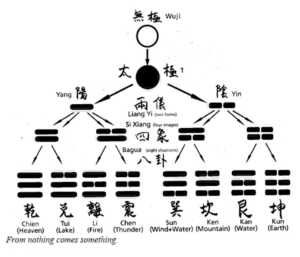
I Ching Trigram (bagua) Construction
In this sense we conceive of reality, or the Platonic notion of Being[2], as a sort of interactive and collective process of becoming or unfolding (Bohm) between the world (Earth), our experience of the world (Man, or mind) and certain a priori, metaphysical constructs or abstractions that give the world its order, or meaning (Heaven). In this sense we conceive of classical Chinese metaphysics being classically Bohmian, if we may coin a term.
We introduce these metaphysical frameworks here so that the reader can see not only some of the source models that we draw from to come up with our model, but also so that as we move into the model description and analysis part of this work the reader can draw on another mode of understanding, analogy, to which our model hopefully encapsulates, crystalizes, and elucidates. In so doing, the reader should, by applying a sort of intellectual triangulation, come to a better understand of what it is that we are proposing, the variables and constructs that we are describing, and the process that underpins these constructs which we are modeling.
What is important to understand here is that metaphysics as we conceive of is not just representative of a system which conceives of mind over matter, but a system which reflects the notion of the existence of a higher order construct, that which we refer to as metaphysics more generally, from which the world of both mind and matter unfold, to borrow Bohmian terminology here. It is from this notion of an implicate order, one that is neither mind nor matter but something more ethereal, something more subtle, from which both mind and matter are generated, and preserved in a constant process of becoming, to borrow Platonic terminology here (Valdez 2015).
The basic component of this higher order metaphysical landscape is what we are calling an idea, or simply i, to be distinguished from the idea of ideas, the form of forms, what Plato calls the Good and Aristotle calls the unmoved mover (Valdez 2015, 2019), the capitalized version, i.e. I. This is not a Platonic form (eidos in Greek, ‘type or species’) necessarily, but it does share the basic characteristics of Platonic forms in that they are pure intellectual constructs. We simply suggest, or hypothesize and take as a starting point for our metaphysics, that the ideas are primary – not their cognition in the human mind as Kant, or Plato for that matter, do.
Ideas then in turn have corresponding conceptions, i.e. concepts, as they are processed or filtered by the mind, which in turn, as directed by the Will (Norman et al 2010; Wicks 2021; Valdez 2022a), attempts to realize said concepts as a function of their own specific makeup, or psychological constituency that we presume follows basic Freudian principles around seeking pleasure and avoiding pain, governed by the mental (res cogitans) and intellectual (res virtualis) structures that govern said reality for said cognitive, sentient being as determined by the basic laws and principles that govern said universe (res logica). This in a nutshell is the description of the Idealogical Mechanics that we describe herein.
In this sense, we invert most metaphysical conceptions of reality as not physicalist, or empiricist – the view which represents the epistemological underpinnings of Physics generally and which is represented in the philosophical systems of the likes of Aristotle, Aquinas, Bacon, Hobbes, Locke, and Hume – and not necessarily rationalist either – as reflected in the philosophical systems of the likes of Plato, Descartes, Leibniz and Spinoza – but more transcendental in the vein of Kant except we take his idea of metaphysics and expand upon it, positing that is ideas in and of themselves that constitute the fabric of reality and that these ideas are processes, transmuted and manifested through the creative and collaborative process of experiential reality – Heaven, Man and Earth coming together to conceive and create reality, and to experience it, in a process of constant flux, ontological movement (holomovement) through which ideas are expressed, evaluated, synthesized and analyzed, understood and intellectualized, modified and revised and then created and experienced again – by each and every sentient being in the universe.
We do not suggest that this is the only way to conceive of, or understand reality, i.e. metaphysics, but we propose that building a specific algebraic formulation of these ideas, their underlying spatial geometry and mechanics through transcendental space, will shed light on both our understanding of psychology, which is concerned exclusively with the notion of mind and its effect on human behavior, cognitive science in terms of its quest to know how the brain functions and processes information, as well as physics in shedding light on how best to interpret the contradictions we find between classical and quantum mechanics.
[1] David Peat, a theoretical physicist who collaborated with Dr. Bohm on several research projects. Quotation from an article on Bohm’s work entitled David Bohm, Implicate Order and Holomovement from the online journal Science & Nonduality: https://www.scienceandnonduality.com/article/david-bohm-implicate-order-and-holomovement.
[2] Plato’s Being (contrasted with Becoming) are two basic metaphysical structures that he introduces in the Timaeus. Being is derived from the Greek word ontos, a derivative of the verb to be, and it is this term that Aristotle uses to define the boundaries of first philosophy, i.e. being qua being, is derived. More on this topic can be found in Valdez 2019 and Cohen et al 2021.

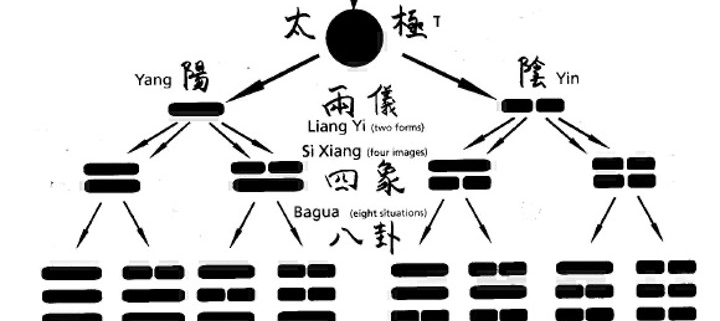
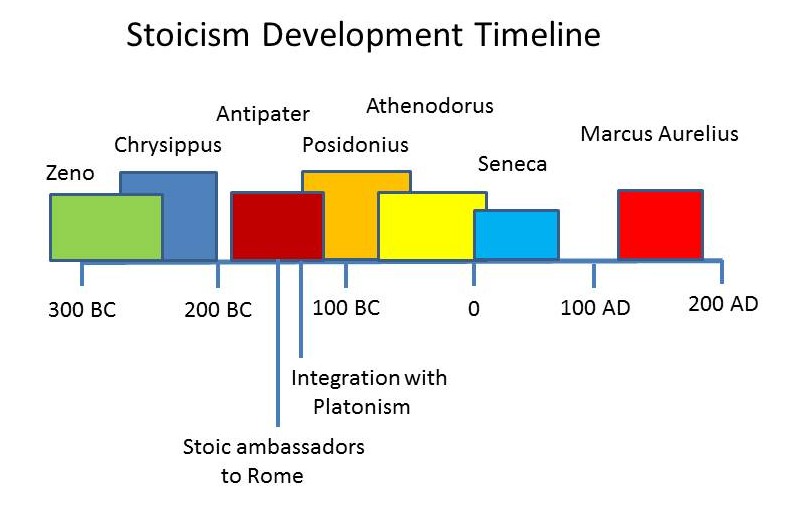

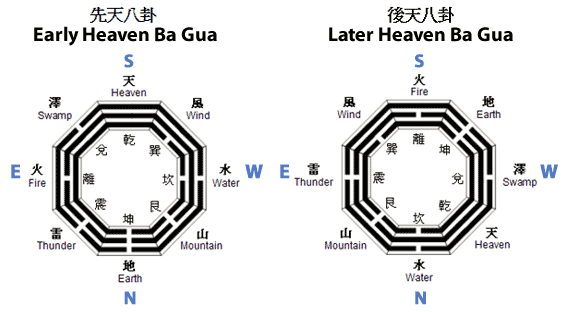

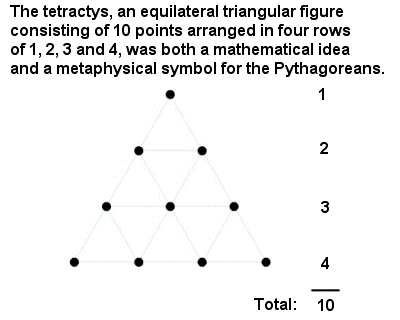

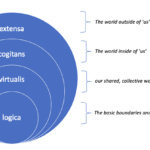
Leave a Reply
Want to join the discussion?Feel free to contribute!